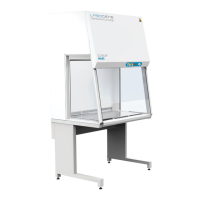7 Cleaning/Decontamination of cabinets
Several procedures can be used for decontaminating the biological safety cabinet. Which procedure
is selected, depends on the potential risk imminent in the products handled, and/or the degree of
cleanliness required by an experiment or work process.
One possible decontamination procedure is to clean, rinse and dry with a disinfection liquid or spray,
and sterile distilled water.
UV disinfection can also be used. It is particularly suited as a more intense disinfection after the
above procedure.
Decontamination using hydrogen peroxide H
2
O
2
can be performed if a sterile working chamber is
required for the work procedure. This decontamination procedure or a similar one is required before
filters are replaced, or before the cabinet is discarded. The control system incorporates a procedure
for this process.
Decontamination using formaldehyde can be performed if a sterile working chamber is required for
the work procedure. This decontamination procedure or a similar one is required before filters are
replaced, or before the cabinet is discarded. The control system incorporates a procedure for this
process.
7.1 Caring for and cleaning of stainless steel
Stainless steel is a combination of many different metals including iron and chromium. Iron, the
primary element in stainless steel, tends to corrode (rust) when in its natural state. The chromium
content in stainless steel prevents corrosion.
Stainless steel is not corrosion or rust proof, just resistant to stains, or stains “less”. The chromium,
in the presence of oxygen, forms a tough, invisible, passive layer of chromium oxide film on the steel
surface. If damaged mechanically or chemically, this film is self-healing as long as it has enough
oxygen. The presence of any liquid or solid that remains in contact with the stainless steel for a
prolonged time can prevent oxygen contact and promote corrosion, as can prolonged contact with
cleaners or disinfectants containing chlorine, ammonia, iodine or other caustic agents.
1. To properly care for stainless steel, use cleaners and disinfectants free of caustic agents
such as chlorine, iodine and ammonia.
2. Always follow the application of any cleaner or disinfectant with a minimum of two clean
distilled water rinses, then a thorough drying with a clean soft cloth. By rinsing with distilled
water and drying, any remaining residue is removed from contact with the stainless steel.

